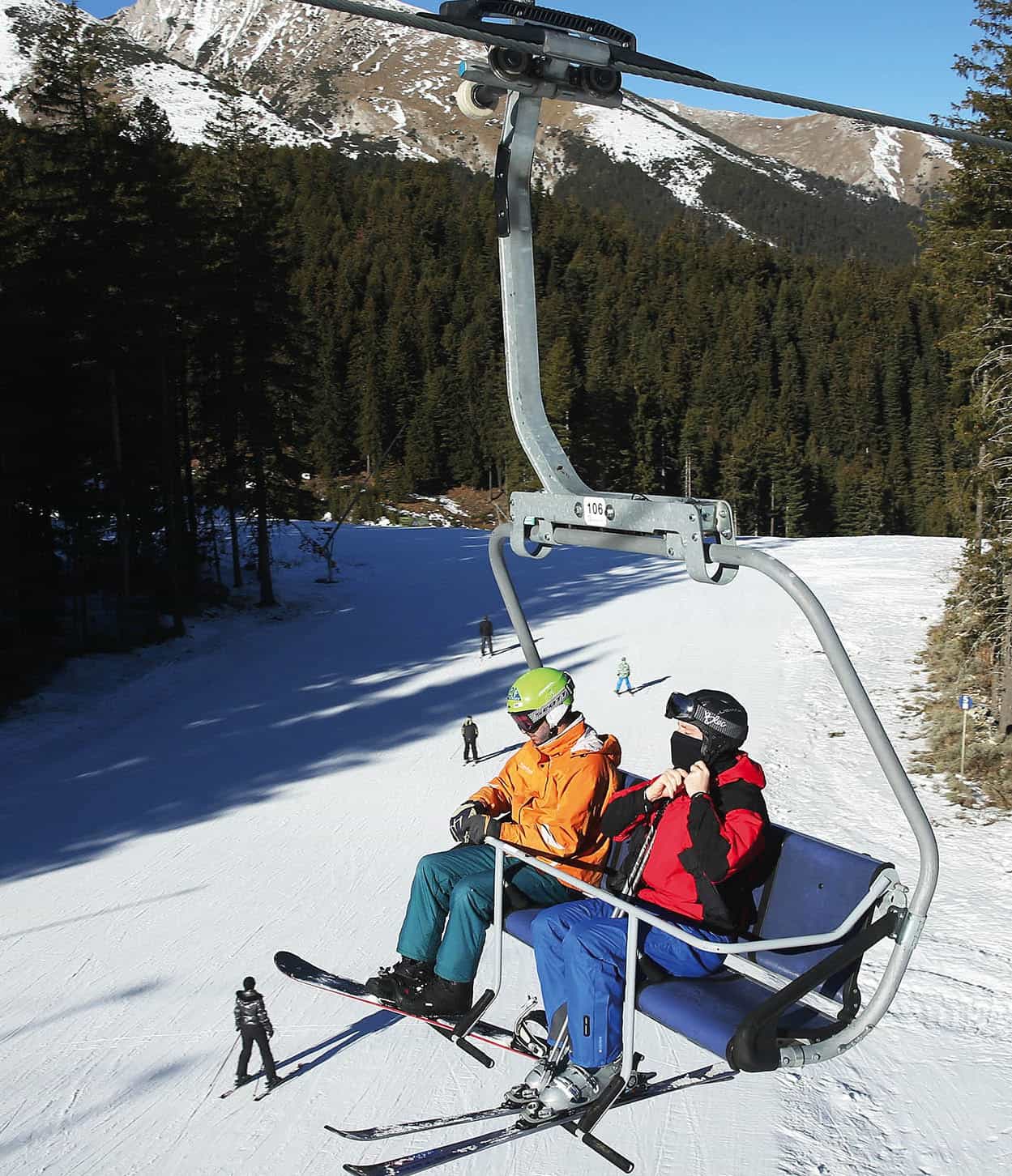
Chairlift at the Bansko ski resort
Getty Images
Sports and Outdoor Pursuits
Skiing
Bulgaria has been a popular destination for budget-conscious skiers for three decades. The main resorts are Borovets, Pamporovo and Bansko, while it is also possible to ski at Vitosha, just a bus ride from the centre of Sofia.
There is usually good snow cover in all of the resorts from late December to the end of March, and you can often ski on the highest slopes at Vitosha and Bansko well into April. While Bulgaria’s skiing is good, however, it is not particularly extensive or challenging. As a rule of thumb, Pamporovo is best suited to beginners, Borovets and Bansko for intermediate skiers, while Vitosha offers the most difficult slopes in the country.
Vitosha apart, all the resorts are well appointed with a variety of hotels, self-catering apartments and places to hire ski equipment. You will pay far more if arriving on spec than if you book accommodation and ski hire before departure. Lift pass prices are increasing, although they are still very low by western European standards – around 35 leva per day. Ski schools are also cheap, and invariably very good. Indeed, for absolute beginners, there are few better places In Europe to learn how to ski or snowboard.
All of Bulgaria’s ski resorts get crowded at the weekends and public holidays when city-dwellers swarm all over them. Vitosha, just 15km (10 miles) from Sofia, is the worst affected, so expect long queues and crowded pistes on Saturday and Sunday. During the week, however, at all of the resorts you may well have the slopes to yourself.
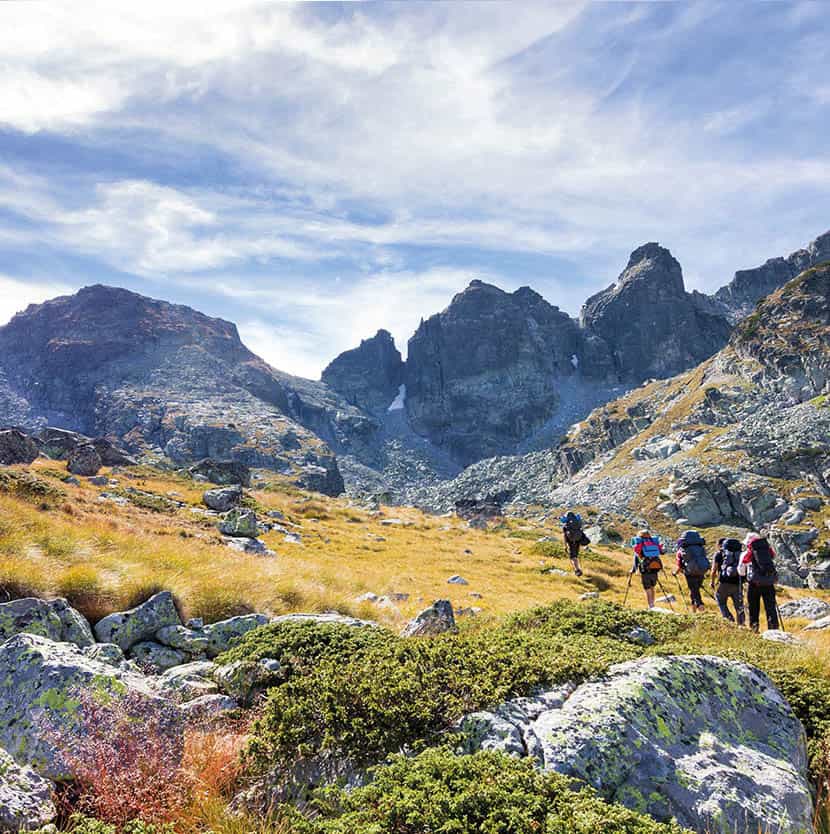
Hikers in Rila National Park
iStock
Hiking and Walking
As spring gives way to summer, skiers give way to hikers and walkers, both local people and international tourists. Unpredictable weather in late spring can mean that snow and freezing temperatures grip the mountains as late as the end of May. The season begins in earnest in June.
Hiking is one of the most popular activities in the country, so hikers are well catered for. The best areas are the Pirin, Rila and Rhodope mountains, all three ranges offering a large number of well-marked routes. For longer hikes you will need to be in possession of a good map before setting off. These can be bought in all good bookshops in Sofia, or in hotels in mountain resorts. Always check weather conditions before heading off; even in high summer the weather can turn in an instant at high altitude.
Most routes are dotted with small cabins – usually open only in summer – where you can buy refreshments and sometimes spend the night for just a few leva.
Mountain Biking
Mountain biking is relatively new in Bulgaria, as is biking of any sort. There are a number of marked tracks laid out for mountain bikers, the best at Pamporovo, Borovets and Bansko. Unless you bring your own bike, head for one of these ski resorts, where you will be able to rent a bike in good condition from a hotel, such as the Rila or Samokov in Borovets, the Pamporovo or Finlandia in Pamporovo, or Pirin or Bansko in Bansko.
Golf
Golf is perhaps the fastest growing sport in Bulgaria, and the country now offers ten full 18-hole courses (there were none a decade or so ago The closest course to the capital is the par-72 St Sofia Golf Club and Spa, 25km (15 miles) east of the capital (www.stsofiagolf.com). There are three par-72 courses in and around Balchik on the Black Sea, with par-71 courses at Sliven and Ihtiman, 50km (30 miles) from Sofia along the Sofia–Plovdiv highway. There are two courses near Borovets, and two near Bansko, including the Ian Woosnam-designed course at the Pirin Golf Club (www.piringolf.bg), regarded as the best in the country. Golf is competitively-priced, if far from cheap, and all ten courses are open to the general public. Expect to pay from 60 leva for a round (more at weekends). All clubs now have resident pros offering lessons.
Sailing
Increasingly popular among the nouveaux riches, leisure sailing is centred on Golden Sands, and there are 11 marinas along the coast. The most popular are the Golden Sands Marina, Port Varna Marina Club and the Bourgas Yacht Club. All have boats for hire, but you will need proof of your sailing credentials.
Football
Bulgarians are mad about football, which remains the most popular spectator sport by some way. The country’s finest hour came in 1994 when the national team – led by the legendary Hristo Stoichkov – narrowly lost to Italy in the World Cup semi-final. Since then, Bulgarian football has been in steady decline. The national team has failed to qualify for a major tournament since the 2004 European Championships, and with the current crop of local talent not considered particularly good, it may be some time before Bulgaria is ready to take its place at football’s top table again. Domestically, however, the game is in surprisingly good shape, with crowds at big games up on those in recent years. Matches between the country’s biggest and most popular sides (Levski and CSKA Sofia, Ludogorets Razgrad and Lokomotiv Plovdiv) are usually sell-outs, and are well worth attending if you can get a ticket. The Bulgarian season runs from July to June, with a break from December to March.
Hunting
Bulgaria’s varied countryside presents opportunities to hunt big and small game, including deer, wild boar, bears, pheasants, ducks and partridges. The rules governing the sport are strict, with annual quotas for each species. Payment is determined by species and size. Shooting a pheasant may cost just a few leva, while hunting a large brown bear may cost thousands of euros. Hunters need an international hunting licence (or at least a hunting license from their home country) and must have special permits to bring their guns into the country.
If you want to hunt in Bulgaria, it is best to have a local travel agent take care of all the paperwork. A number of travel agents specialise in hunting holidays, including Sofia-based BHS (www.huntservice.com).
Fishing
Fishing is popular all over the country. Freshwater fishing is especially good in the Rila Mountains where, depending on the season, you can find carp, mullet, pike and pike-perch, with only May (the spawning season) off-limits. The Black Sea offers huge numbers of saltwater fish, including turbot, mackerel and tunny fish. There is no angling off-season on the coast. A small dog shark is also found in the Black Sea and it can be fished from a boat around 4km (2 miles) off the coast. Most Sofia tour agencies can make arrangements for angling safaris.
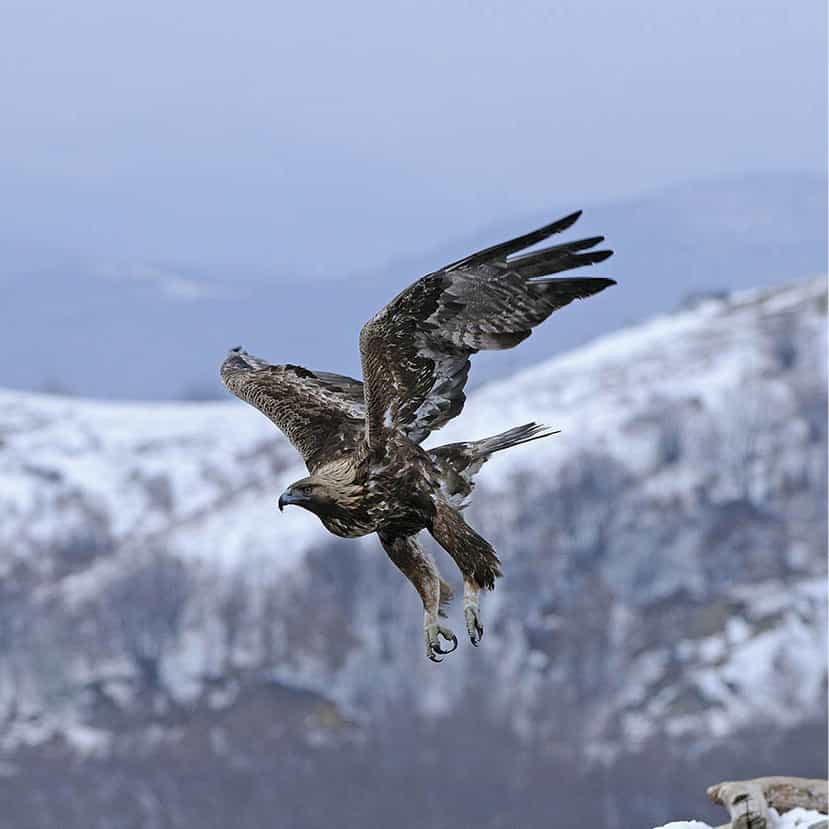
Golden Eagle in the Carpathian Mountains
FLPA/REX/Shutterstock
Birdwatching
Once a well-kept secret, Bulgaria’s reputation for birdwatching has become more widely known in recent years, and the country is fast becoming one of Europe’s top birdwatching destinations. Two areas in particular offer a great range of bird species: the marshlands around Bourgas and the Madzharovo nature reserve in the Rhodope Mountains. The more than 500 kinds of bird that either nest in Bulgaria in spring or pass through on migration in the autumn, include the Dalmatian pelican, glossy ibis, spoonbill, black stork, pygmy cormorant, ferruginous duck, Egyptian, black and griffon vultures, Levant sparrow-hawk, long-legged buzzard, peregrine falcon and white-tailed, golden and eastern imperial eagles.
Among the tour operators offering birdwatching excursions is Sofia-based Pandion (www.birdwatchingholidays.com), which can help with all aspects of birdwatching, from booking hotels to tailor-made, fully escorted tours. Pandion also offers butterfly and dragon-fly-spotting tours. Independent birdwatchers should come in spring to Pamporovo, a good base in the Rhodopes, and to Bourgas in the autumn. Even the casual observer will, however, notice a profusion of birdlife at any time of year in almost any rural setting.
Shopping
Bulgaria is by no means a shopper’s paradise, but it does offer some of the best shopping in the Balkans. During the Communist period there wasn’t much to interest anyone, and while Bulgarian shops were never as barren and depressingly deserted as their Romanian counterparts, it was still difficult to purchase many consumer goods without having to wait for some time. All that has changed. Economic reform may not have been as fast as that of other former Communist countries, but when it comes to consumer commerce, the Bulgarians now lead the way.
In the days of the ‘wild East’ – immediately following the collapse of the Communist regime – almost anything could be bought for any price. Although those days have gone, you will still find a few forbidden fruits in the country’s flea markets, most notably counterfeit CDs and DVDs, production of which is one of the country’s biggest industries (for more information, click here).
Shops in general are open all day until around 6pm. Note that customer service is still non-existent. Credit cards are now accepted in all but the smallest stores, although using one invariably provokes muttering.
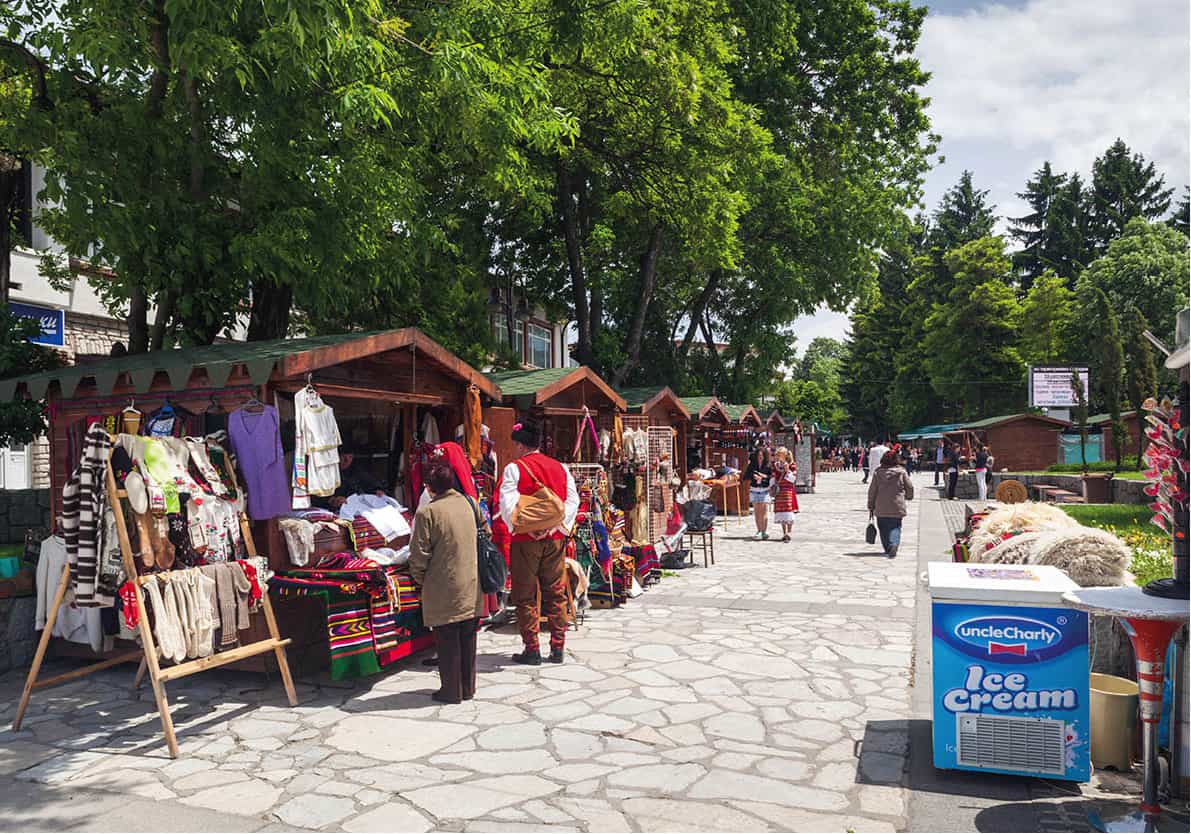
Souvenir stalls on Ploshtad Nikola Vaptsarov, Bansko
Getty Images
Markets and Malls
Prices in general can be divided into two categories: cheap (if the product is made in Bulgaria) and expensive (if the product is imported). While haggling has long been a Balkan necessity, it is now frowned upon in all but the most provincial markets. Try it in a chic boutique in Sofia and the police may be called.
Most of Bulgaria’s groceries are still purchased early in the morning at markets, and produce is strictly seasonal. Imported goods can be found out of season only in expensive supermarkets. Almost everything else is sold in standard high-street shops or malls. The biggest is Mall of Sofia, which also boasts the only IMAX cinema in the country. There are also a number of flea markets for those who know where to look. The biggest and best is the one in front of the Alexander Nevski Cathedral in Sofia. If you are looking for a genuine Third Reich fountain pen, then this is the place to come, while busts of Lenin and Stalin and posters of Todor Zhivkov and other Communist heroes are also popular. Russian army hats are two a penny, while medals, watches and other Soviet memorabilia – all of which may or may not be original – can be bought for peanuts. Directly next to the flea market is another one, selling Orthodox iconography and naive art which, while not cheap, is good quality and a very good place to hunt for souvenirs.
The Black Sea coast’s numerous street hawkers sell little else but sunglasses, beachwear and accessories, most of which is terribly poor in terms of quality. Ski resorts attract the winter equivalent of these hawkers. Sports shops in the ski resorts can offer bargain ski equipment, as a number of Western brands manufacture in Bulgaria under licence, and prices for skis and ski boots are much cheaper here than in Western Europe, especially after the end of February.
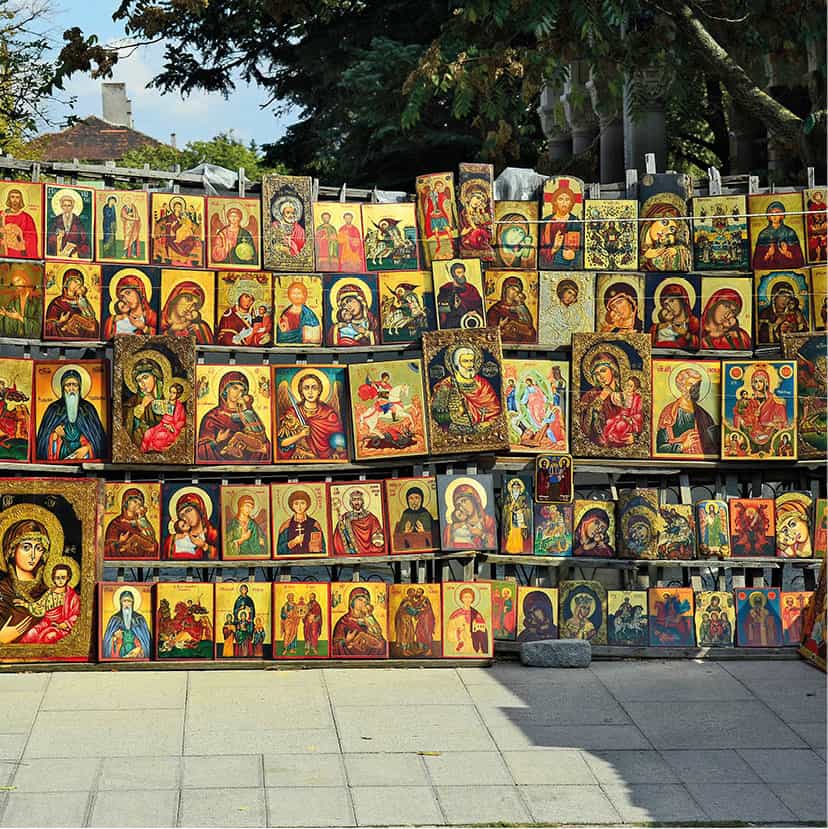
Icons for sale in Sofia
iStock
What to Buy
Traditional Bulgarian handicrafts offer a wide choice of wares. These include lace, pottery, woodcarvings and iconography. Bulgarian souvenir shops are ubiquitous, though the souvenirs themselves can be of variable quality.
Reproductions of Orthodox iconography and wood carvings can be bought all over the country, with the best quality being found in Sofia in the art market outside the Alexander Nevski Cathedral. As a general rule, the stuff sold by hawkers and stallholders outside the more famous Bulgarian monasteries should be bought only in a souvenir emergency, as quality is patchy at best.
If you are after genuine antique icons, as opposed to reproductions, you should contact a professional art dealer and have a reasonable idea of what you are looking for. Exporting antiques is a difficult process requiring a long paper chase that a dealer will be able to handle with ease. Only the brave should attempt to do it on their own. There are a number of galleries in Sofia clustered together on the streets around the Radisson Hotel. Any of them will be delighted to help.
The manufacture of fine pottery in this part of the world dates back as far as the Thracians, and the work of Bulgarian potters is traditionally sacred, with know-how a closely guarded secret kept within families of potters. Pottery first flourished during the 12th to 14th centuries, only to go into abeyance during the Turkish Yoke, before being resurrected during the National Revival period. This is when Berkovitsa and Gabrovo became bywords for excellence in the field, their green, brown and yellow creations a Bulgarian trademark. Over the last hundred years or so the craft has somewhat died out, and today only a few potteries remain, mostly as working museums. The Etura complex near Gabrovo (for more information, click here) is a fine example of this kind of living museum and an excellent place to purchase exquisite handmade Bulgarian pottery, as is the market in pl Samodivska in Veliko Tarnovo.
Etura is also a good location to find embroidery and lace, though the best place is probably along the coast, especially in Varna, as there is so much choice and competition between the old ladies who throng the market that surrounds the Cathedral of the Virgin Mary. Quality here is high and prices are reasonable, though not cheap. You can try haggling but few of these babushki speak any English, and may not understand your attempts to get the price of an item down.
Faking It
Bulgaria remains one of the world’s largest producers of fake CDs and DVDs, despite repeated calls from the European Union to stamp out their production, retail and export. The government makes occasional high-profile raids on illegal factories, but these do little real damage to what is a multi-billion euro industry. All Bulgarian towns and cities are full of street retailers brazenly offering discs for sale, usually a mind-boggling selection of the most up-to-date music, as well as back-catalogues. In most cases if the vendor does not have the particular album you are looking for, he will have one made for you overnight.
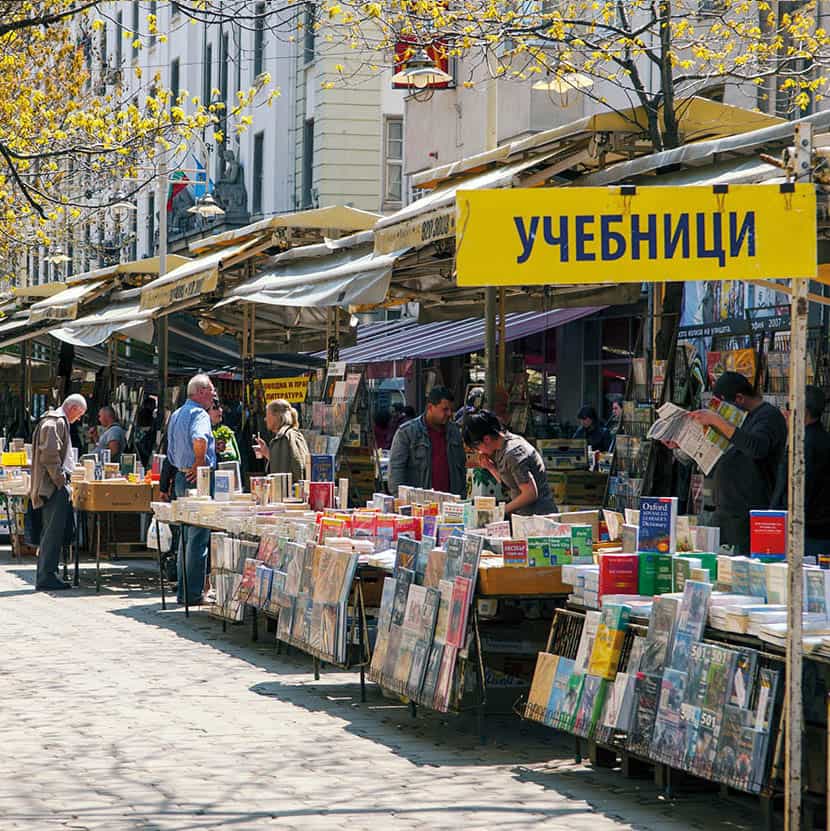
Book market in Sofia
iStock
Where to Shop
Sofia. Vitosha Boulevard is the country’s top shopping street, though you will not find anything here that cannot be bought (often cheaper) in your home country. The best souvenir shops in the capital are those on the second floor of the TZUM department store and in the underpass leading from the Presidency to the Largo. The Halite grocery market can be fun in the early mornings, while the Zhenski Pazar (Women’s Market) is another good place to hunt for bargains. Graf Ignatiev Boulevard is home to an excellent second-hand book market, as well as an outlet for counterfeit CDs and DVDs. There are now also two big modern malls in Sofia: the Mall of Sofia, on the city’s outskirts, and City Center Sofia, closer to the centre of town.
Plovdiv. The pedestrian only Alexander I Boulevard, which leads from pl Tsentralen towards Old Plovdiv, is the city’s foremost shopping throughfare, and has numerous cafés, restaurants and bars. There is an excellent daily market situated on ul Raichio, on the southern side of pl Tsentralen, where good, cheap forgeries of all your favourite brand-name clothes are a speciality.
Varna. Knyaz Boris I Boulevard, from pl Nezavisimost to Tsar Osvoboditel Boulevard, has perhaps the best selection of shops anywhere in Bulgaria. All the major international brand names have boutiques on the street, and these often sit side by side with discount stores selling counterfeit versions of the same goods. Varna is also home to a number of nautical shops, some selling tacky souvenirs, others selling professional sailing gear. The market outside the cathedral is the best place in the country to find lace and embroidery, although the flea market situated on the other side of the main road sells only rubbish to tourists who should know better.
Entertainment
Nightlife and Café Culture
Bulgaria is now one of Europe’s best places for good value nightlife. Sophisticated clubs and discos come and go (especially on the coast) with startling regularity, opening up in a blaze of glory before closing just months later as the country’s hip crowd moves on to somewhere new. There is something for all tastes and pockets: from the brash discos to smooth jazz cafés and Irish pubs.
Given its sheer size and wide choice of bars and discos, Sofia is probably best for nightlife, while all the Black Sea resorts, especially Golden Sands and Sunny Beach, have a reputation for long, long nights and also have a number of casinos. Varna, too, has a profusion of good discos along its seafront. The ski resorts, catering mainly for foreign tourists, also have good night-time options, while the student town of Blagoevgrad is a major nightlife centre for the young during term-time.
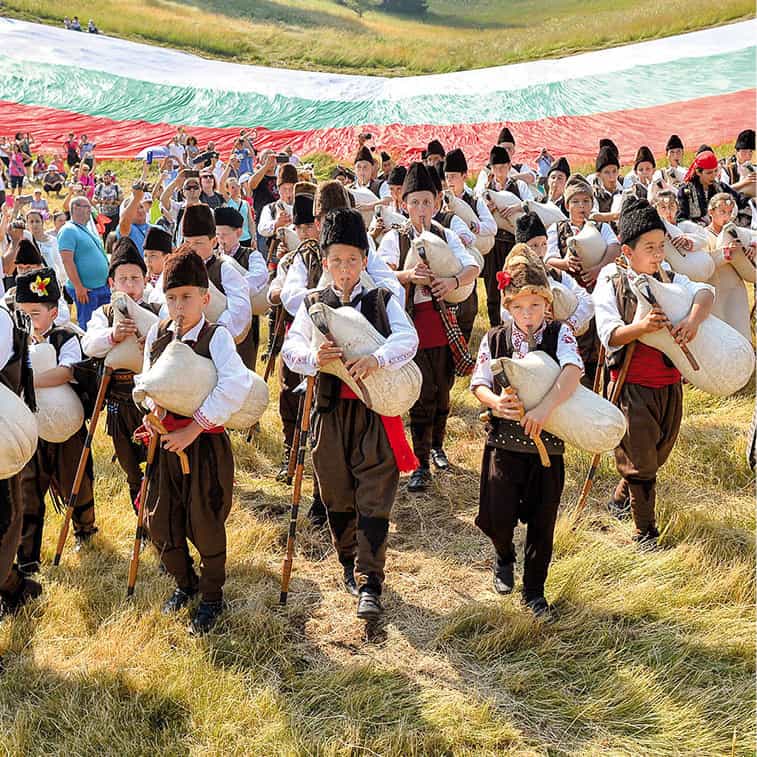
Gaida players at a festival in Rozhen
Shutterstock
Cultural Performances
The cultural capital of the country remains Plovdiv, where the Roman Amphitheatre stages world-class music and theatre throughout the summer. Varna also has a number of festivals, including the Varna International Pop Music Festival, held at various venues throughout the city every May, with performers of variable ability, though there is usually at least one major international star. Far more satisfactory is the Varna Classical Summer Festival, held every June and featuring big names from the world of Bulgarian and international music and opera.
The Sofia National Opera is the country’s most famous opera, though the standard of performances depends on the singers on stage on any particular night, as those most in demand are often performing elsewhere.
There are good operas at Blagoevgrad, Varna and Plovdiv. The country’s best performers congregate at Plovdiv in the summer when they perform at the amphitheatre. Tickets are invariably cheap and represent excellent value for money.
Kukeri Festivals
Almost certainly Thracian in origin, the Kukeri festivals are probably the most bewildering sights in Bulgaria for the uninitiated. At various times throughout the year – usually at New Year or in spring – participants (always male) dress up in animal skins – including elaborate, fearsome masks often made from animal heads – and enter a trance-like state before parading through towns and villages manically chanting, dancing, shouting, singing, and generally acting in a way that will make evil spirits think twice before returning. The parades can last all day and mock executions are often enacted to symbolise the death of winter.
As recently as the 19th century, the tradition was common all over the country but today just a few large Kukeri festivals remain. The best places to see them are Pernik, a small town 25km (15 miles) west of Sofia, during the last weekend of January; and Shiroka Luka, close to Pamporovo, on the first Sunday in March.
Folk Music
Among connoisseurs, traditional Bulgarian music – especially female singing – is respected and renowned worldwide. It may well be one day enjoyed in other galaxies – one of the Voyager rockets launched in the 1970s, in the hope of it eventually being picked up by other life forms, includes a Bulgarian folk song from the Rhodopes on a gilded copper gramophone record.
To hear Bulgarian music closer to earth, you should head for the Pirin Song Festival held every August, or buy any of the excellent compilation cassettes and CDs of Bulgarian music that can be found in music stores and souvenir shops.
Traditional instruments include the gaida (bagpipes), the kaval (shepherd’s pipes), the brumbuzuk (a small pipe) and chans (sheep’s bells). All are impossibly difficult to play but make extraordinary music when performed well. One of the best places to see traditional music being performed is at any restaurant offering a folk programme. Though often designed for tourists, they are usually very good value.
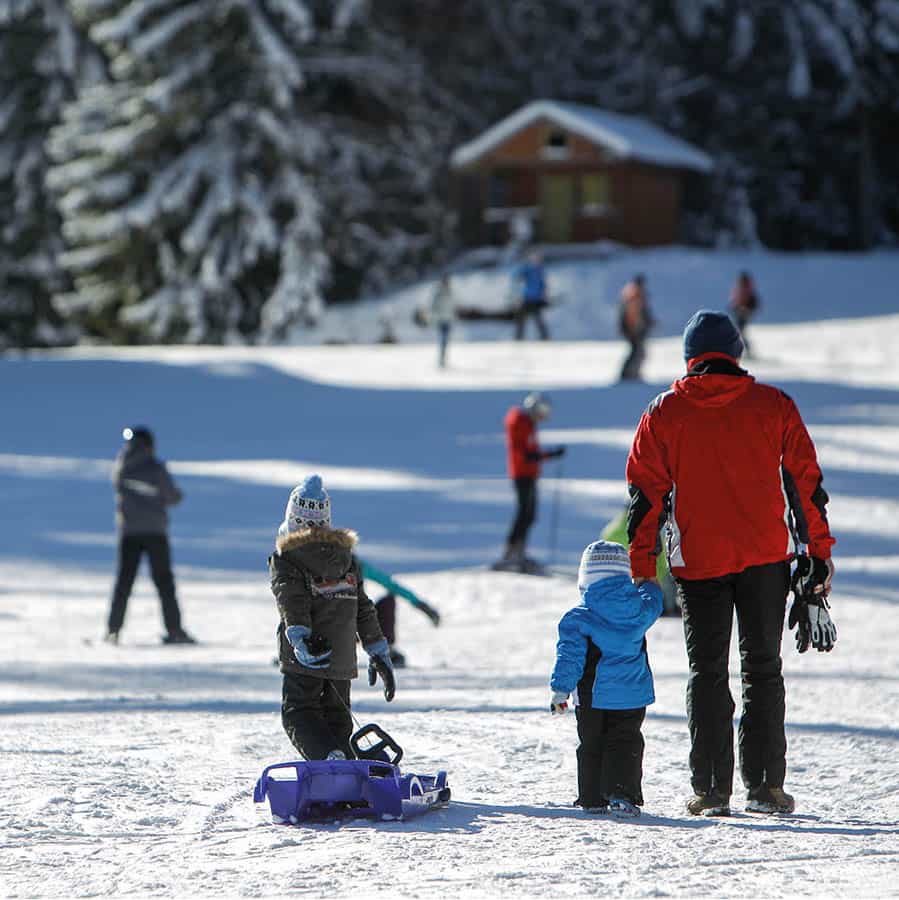
Family on the slopes, Dobrinishte
Shutterstock
Children’s Bulgaria
Bulgaria’s seaside and ski resorts are terrific destinations for families, as accommodation is excellent value and children’s activities are relatively cheap. There are water parks up and down the Black Sea coast, with plenty of places to swim or try water sports. Do be careful when taking part in any water sports, however, as not all sports centres have the correct authorisation. It is best to head for an activity centre attached to a good hotel. Shows at the dolphinarium in Varna are popular with children of all ages.
Three of the main ski resorts – Bansko, Borovets and Pamporovo – have specialist children’s ski schools that organise snow crèches, children’s races and other competitions. Bansko is the favourite resort of families as it offers other, non-skiing activities such as ice skating and sleigh rides.
There are many things for children to do in and around Sofia, from ceramic painting on the ground floor of TZUM to Sofia Zoo, which has large, open areas for children to explore in safety. Although the Sofia Land amusement park is currently closed due to security issues, the Puppet Theatre, at 14 ul Gurko (www.sofiapuppet.com), will keep children amused, even though all performances are in Bulgarian. There is a children’s swimming pool at the Hotel Princess, and all the major hotels organise Sunday brunches with entertainment for children.
Bulgarians in general love children and will go out of their way to accommodate them. The main problem with children is keeping them amused while travelling from place to place, as roads are poor and trains slow, meaning that travelling times can be long.
Food should not be a problem, as Bulgarians themselves are not fond of spicy foods, while universal children’s favourites, such as omelettes, or steak with chips, are found on every menu in the country.